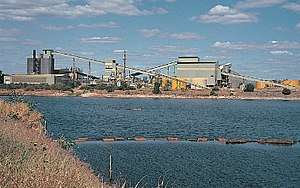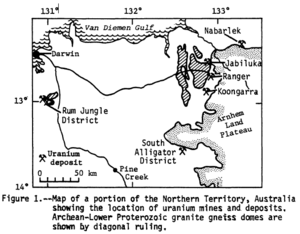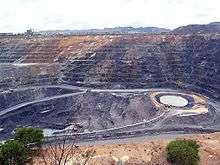Ranger Uranium Mine
The Ranger Uranium Mine is a uranium mine in the Northern Territory of Australia. It is surrounded by, but separate from Kakadu National Park, 230 km east of Darwin. The orebody was discovered in late 1969, and the mine commenced operation in 1980, reaching full production of uranium oxide in 1981. It is operated by Energy Resources of Australia, a 68% subsidiary of Rio Tinto Group. Uranium mined at Ranger is sold for use in nuclear power stations in Asia, Europe and North America.[1]
 Ranger mill complex | |
| Location | |
|---|---|
 Ranger Uranium Mine Location in the Northern Territory | |
| Location | Kakadu National Park |
| Territory | |
| Country | Australia |
| Coordinates | 12°41′S 132°55′E |
| Production | |
| Products | Uranium |
| History | |
| Discovered | 1969 |
| Opened | 1980 |
| Owner | |
| Company | Energy Resources of Australia Limited |
| Website | http://www.energyres.com.au/ |

The original orebody was completely mined out by the end of 1995, although some ore remains stockpiled. A second orebody ("Ranger 3") began mining in 1997. Both have been open-pit mines. Open cut mining finished at Ranger in late 2012 and the mine is now processing stockpiled ore.[2]
As of 2013, the ageing Ranger mine has been incurring financial losses as a result of the continuing market slump which has followed the 2011 Fukushima nuclear disaster. Water management and waste management continue to be controversial issues.[2]
Discovery and operation of the mine

The Ranger uranium orebody, the richest in the Southern Hemisphere, was discovered in late 1969, when an aerial radiometric survey conducted by Geophysical Resources Development Co., a company based in Sydney, on contract to Noranda Aluminum, Inc., detected a large spike in gamma radiation when passing over Mount Brockman, known as Djidbidjidbi to the Mirarr traditional owners of the area. The instrument that detected the anomaly was a Nuclear Enterprises gamma ray spectrometer using a Thallium doped Sodium Iodide cylindrical crystal. At time of discovery the aircraft was flying at an altitude of 100 meters. The anomaly could still be detected at almost 3000 feet. The Aircraft was a Britten Norman Islander Registration VH-FLE. The crew members on board were Bill Hay, the pilot, Harvey Morton, the navigator and Frank Lanza, the instruments operator that actually first recognized the significance of the anomaly.
The Ranger No. 1 and Ranger No. 3 ore bodies occur in the Cahill Formation, consisting of Lower Proterozoic metasediments, located in the Alligator Rivers Uranium Field.[3][4] The mine commenced operation in 1980, reaching full production of uranium oxide in 1981. Owing to the environmental sensitivity of the site, a special statutory authority, the Supervising Scientist, was created to provide oversight of the operation and conduct environmental research in the region.
Ranger mine covers two of a line of uranium orebodies that extend from near Nourlangie Rock in Kakadu north-eastwards to Koongarra, underneath Mount Brockman, then northwards through the Ranger One line of orebodies (in order Number 2, Number 1, and Number 3), then via Hades Flat, where there is uranium mineralisation, to Jabiluka where the line turns westward through the Barote and Ranger 4 orebodies. The mine covers No 1 Orebody and No 3 Orebody. No 2 orebody was excluded from the mining lease at the request of the traditional owners and included in Kakadu National Park. From Ranger 4 the line again turns northwards and then swings westward round an Archaean basement dome before turning south towards Nourlangie Rock again. Uranium mineralisation is known at several other places along this line but has never been explored in detail because of the creation of Kakadu. The name 'Ranger' for the series of discoveries made by Geopeko Limited, the exploration arm of the Australian mining company Peko-Wallsend Limited, in the period 1969 to 1972, was thought up by Judy Ryan, the wife of the geologist in charge of the program. Koongarra and Jabiluka were retained by the companies that found them: Noranda Australia and Pancontinental Mining respectively, although since sold to other parties. The other discoveries are enclosed in the National Park, locking up an energy source that is estimated to be greater than the oil reserves of Saudi Arabia. (12)
Energy Resources of Australia Ltd (ERA) was named Explorer of the Year at the sixth annual Australian Mining Prospect Awards held in Sydney on Wednesday 11 November 2009. During 2008, ERA's exploration programme identified a very significant mineral resource adjacent to the existing Ranger 3 operating pit. The area, known as Ranger 3 Deeps, is estimated to contain 34 thousand tonnes of contained uranium oxide, and ranks among the world's most significant uranium discoveries in recent years.[5]
Ranger 3 Deeps
ERA is constructing a $120 million Ranger 3 Deeps exploration decline to conduct close spaced underground exploration drilling and explore areas adjacent to the Ranger 3 Deeps resource. The Ranger 3 Deeps mineralised zone contains an estimated 34,000 tonnes of uranium oxide, and represents one of the most significant recent uranium discoveries world-wide.
In parallel with the construction of the exploration decline, ERA began a $57 million project to prepare a Prefeasibility Study into the potential development of a Ranger 3 Deeps underground mine. This Study will determine the economic viability of the project, optimise mining methods, and confirm metallurgical performance and production rates. Environmental studies will also be conducted. ERA will also consult further with the Gundjeihmi Aboriginal Corporation as a component of a broader social impact assessment.[6]
ERA formally commenced the statutory approval process for the proposed Ranger 3 Deeps underground mine with the submission of a referral to the Commonwealth Department of Sustainability, Environment, Water Population and Communities under the Environmental Protection and Biodiversity Control Act 1999 in January 2013. At the same time, ERA separately lodged a notice of intent with the Northern Territory Environment Protection Authority under the Northern Territory Environmental Assessment Act.
Ore processing
Ore is ground, then leached with sulfuric acid. Uranium is removed using kerosene with amine then stripped with ammonium sulfate solution and gaseous ammonia. Ammonium diuranate is precipitated by increased pH and converted to uranium oxide (U3O8) in a furnace.[1]
In early 2006, ERA announced an expansion to the ore processing plant which will allow production to extend into lower-grade material and in November 2006 the company announced plans to invest in a laterite processing plant, which will allow it to process ore with a high clay content that has been stockpiled since the mine began operating. This ore had been already included in stated reserves. The laterite processing plant will contribute 400 tonnes of uranium oxide per year from 2008 until 2014.[7]
Water management
Water management is a critical component of ERA’s business, and between 2009 and 2012, ERA completed water management projects for a total cost of $82 million.[8] This included surface water interception trenches around stockpiles to protect local waterways, installation of continuous real-time monitoring stations, and additional ground water bores to augment the extensive ground water monitoring programme.
In addition, ERA completed a 2.3 metre life of the Tailings Storage Facility, constructed a new pond water retention pond to store up to one gigalitre of pond water, and installed contingency water pumping system between the Tailings Storage Facility and Pit 3. From 2012 to 2014, ERA expects to expend a total of $316 million in various water management projects including the $220 million Brine Concentrator Project.[8] Brine Concentrators use thermal energy to evaporate water, which is subsequently condensed and discharged as clean distilled water.
Assembly of the components began in November 2012 and the Brine Concentrator is expected to be commissioned and fully operational in Q3 2013. The Brine Concentrator has the capacity to produce 1.83 gigalitres of clean water per year through the treatment of process water.[9] Hatch was appointed EPCM contractor for the Brine Concentrator project. It was successfully commissioned on November 2013 with a budget of AUD $220 Million dollars.[10]
In 2012, ERA and the Mirarr Traditional Owners represented by the Gundjeihmi Aboriginal Corporation (GAC), conducted a jointly facilitated independent expert review of the quality of surface water around the Ranger Project Area. The Independent Surface Water Working Group consisted of representatives from ERA, GAC, the Supervising Scientists Division and the Northern Land Council.
Over a six-month period, the working group examined the impacts, monitoring and reporting of surface water flowing from the Ranger mine.
The working group agreed in findings released in March 2013 that the current surface water management and regulatory systems in place at the Ranger mine are of a very high standard.[11] Going forward, the Group has agreed upon an action plan to ensure that surface water management systems at Ranger remain best leading practice.
Safety breaches and controversy
Environment Australia (an agency of the Government of Australia) have documented over 200 environmental incidents since 1979. The great majority of these were minor, but the significant ones are detailed below.[12]
In May 2005 the company was convicted for breaching environmental guidelines - the first such prosecution of a mining company in the Northern Territory, relating to accidental radiological exposure to ERA employees.[13] Radiologically contaminated process water had contaminated the drinking water supply and some workers drank and washed in the contaminated water. The maximum radiation exposure of workers was likely to have been much less than the regulatory limit, and no harmful long-term health effects are likely.[14]
Other incidents involving decontamination of vehicles have been identified.[14] When the work-for-welfare mechanic in Jabiru opened the engine bay, he was unaware of the nature of the mud and dirt which fell on the floor. The court heard that in the following weeks, after he had swept the material outside his shed, his children played and built sandcastles in mud contaminated with uranium.[15]
Another significant controversy over Ranger's environmental impact is the public legal confrontation over releases into Magela Creek in the 1995 wet season. More recently, the ARRAC report from 2002 details a major leak of about 2 megalitres of potentially polluted water, over a number of months. In 2007, water breached a retention pond, overflowing back into the pit. The original authorisation required that this water be contained at all times. In 2006, water management systems were knocked into disarray by Cyclone Monica.
In May 2010, it was reported that a tailings dam may have released millions of litres of radioactive water into world heritage-listed wetlands in Kakadu National Park, home to about 500 Aboriginal people.[16]
On 7 December 2013 there was an incident at a mine site inside Kakadu National Park, with about a million litres of slurry, comprising crushed ore and acid, believed spilled, workers evacuated and production shut down. A leaching tank containing the slurry burst at about 1am. The spilled material was entirely contained within the safety bunds and no material leaked into the wider ecosystem.[17][18]
See also
- McArthur River uranium mine in the Athabasca Basin in Saskatchewan Canada
- List of uranium mines
- Unconformity uranium deposits
- Uranium mining
- Uranium market
- Uranium mining in Australia
- Russell Walter Fox
References
- "Ranger". Australia's Uranium Mines. World Nuclear Association. Retrieved 12 January 2009.
- Dave Sweeney (7 November 2013). "Old mine, new problems: Another failure at Kakadu uranium mine". ACF Online.
- Zoellner, Tom (2009). Uranium. New York: Penguin Books. pp. 180–181. ISBN 9780143116721.
- Nash, J. Thomas; Frishman, David (1983). Chemical Data and Statistical Interpretations for Rocks and Ores from the Ranger Uranium Mine N.T., Australia, USGS Open-File Report 83-239. US Government. p. 2.
- http://www.energyres.com.au/media/38_media_releases_2447.asp
- http://www.energyres.com.au/whatwedo/2324_ranger_3_deeps_exploration_decline.asp
- "ERA Approves Laterite Processing Plant". ASX announcement. Energy Resources of Australia. 29 November 2006. Archived from the original on 24 May 2011. Retrieved 16 January 2007.
- Energy Resources of Australia 2012 Annual Report, pg 32
- Energy Resources of Australia 2012 Annual Report, pg 18
- "EPCM Services". Digiscend.com. 2014. Retrieved 21 August 2014.
- http://www.energyres.com.au/media/38_media_releases_2959.asp
- "Regulating the Ranger, Jabiluka, Beverly and Honeymoon uranium mines - Appendix 6" (PDF). Senate Environment, Communications, Information Technology and the Arts Committee. 14 October 2003.
- John Carroll v Energy Resources of Australia [2005] NTMC 067
- "Contamination incidents at Ranger mine". Department of the Environment and Heritage annual report 2004-05. Australian Department of the Environment and Heritage. 2005. ISSN 1441-9335. Retrieved 15 January 2007.
- "ERA fined $150,000 over contamination". The Age. 1 June 2005. Retrieved 15 January 2007.
- MURDOCH, LINDSAY (24 May 2010). "Kakadu being poisoned by Rio Tinto mine, group warns". Brisbane Times. Retrieved 25 May 2010.
- "Radioactive acid spill at ERA Ranger mine in Kakadu". The Australian. 7 December 2013.
- "Uranium mine spill near Jabiru, Northern Territory, locals fear for Kakadu National Park". ABC News. Australian Broadcasting Corporation. 7 December 2013. Retrieved 7 December 2013.
- IAEA, 1980. URANIUM IN THE PINE CREEK GEOSYNCLINE (Eds J Ferguson and A B Goleby). Proceedings of the international symposium on the Pine Creek Geosyncline, Int. Atomic Energy Agency, Sydney, Australia, 4–8 June 1979.
External links
| Wikimedia Commons has media related to Ranger Uranium Mine. |